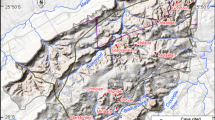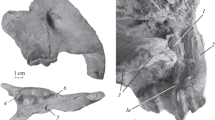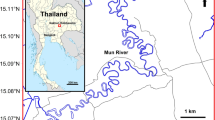Abstract
A new genus and species of catshark (Neoselachii, Carcharhiniformes, Scyliorhinidae) —Bavariscyllium tischlingeri n. gen. n. sp. — is described from the Late Jurassic (Tithonian) Plattenkalke of South Germany. The new taxon is known from a single articulated skeleton having the skull, the trunk and all of the fins preserved. The position of the first dorsal fin in relation to the pelvic fins and the dental morphology shows that the specimen belongs into the neoselachian family Scyliorhinidae. Two isolated tooth crowns from the Kimmeridgian of North Germany are identified asBavariscyllium sp. and represent the oldest unambigious fossil record of the Scyliorhinidae known so far.
Kurzfassung
Auf der Basis eines artikulierten Skelettes mit Schädel und allen Flossen aus den oberjurassischen (tithonzeitlichen) Plattenkalken Süddeutschlands wird eine neue Gattung und Art von Katzenhaien (Neoselachii, Carcharhiniformes, Scyliorhinidae) —Bavariscyllium tischlingeri n. gen. n. sp. — beschrieben. Die Stellung der ersten Rückenflosse im Verhältnis zu den Bauchflossen sowie die Zahnmorphologie belegen eindeutig die Zugehörigkeit vonBavariscyllium tischlingeri n. gen. n. sp. zur Neoselachierfamilie Scyliorhinidae. Zwei isolierte Zähne aus dem Oberjura (Kimmeridgium) von Norddeutschland werdenBavariscyllium sp. zugeordnet und stellen die bislang ältesten unzweifelhaften fossilen Reste der Scyliorhinidae dar.
Similar content being viewed by others
References
Agassiz, L.J.R. 1843. Recherches sur les poissons fossiles.3. — 157–390, Neuchatel (Petitpierre).
Bass, A.J. 1973. Analysis and description of variation in the proportional dimensions of scyliorhinid, carcharhinid and sphyrnid sharks. — South African Association for Marine Biological Research, Oceanographic Research Institute, Investigational Report32: 1–28.
Bass, A.J.;D’Aubrey, J.D. &Kistnasamy, N. 1975. Sharks of the east coast of southern Africa. 2. The families Scyliorhinidae and Pseudotriakidae. — South African Association for Marine Biological Research, Oceanographic Research Institute, Investigational Report37: 1–63.
Böttcher, R. &Duffin, C.J. 2000. The neoselachian sharkSphenodus from the Late Kimmeridgian (Late Jurassic) of Nusplingen and Egesheim (Baden-Württemberg, Germany). — Stuttgarter Beiträge zur Naturkunde (B)283: 1–31.
Candoni, L. 1993. Découverte deParasymbolus octevillensis gen. et sp. nov. (Scyliorhinidae-Elasmobranchii) dans le Kimméridgien de Normandie, France. — In:Herman, J. &Waes, H. van, eds., Elasmobranches et Stratigraphie. — Service Géologique de Belgique, Professional Paper 1993/6264: 147–156.
Cappetta, H. 1987. Chondrichthyes 2. Mesozoic and Cenozoic Elasmobranchii. — In:Schultze, H.-P., ed., Handbook of Palaeoichthyology3B: 1–193, Stuttgart (G. Fischer).
Cavin, L., Cappetta, H. &Séret, B. 1995. Révision deBelemnobatis morinicus (Sauvage, 1873) du Portlandien du Boulonnais (Pasde-Calais, France). Comparaison avec quelques Rhinobatidae Jurassic. — Geologica et Palaeontologica29: 245–267.
Compagno, L.J.V. 1977. Phyletic relationships of living sharks and rays. — American Zoologist17: 303–322.
Compagno, L.J.V. 1984a. FAO species catalogue. Sharks of the world. An annotated and illustrated catalogue of sharks species known to date. 1. Hexanchiformes to Lamniformes. — FAO Fisheries Synopsis (125)4 (1): i-viii, 1–249.
Compagno, L.J.V. 1984b. FAO species catalogue. Sharks of the world. An annotated and illustrated catalogue of sharks species known to date. 2. Carcharhiniformes. — FAO Fisheries Synopsis (125)4 (2): i-x, 251–655.
Duffin, C.J. 1993. The palaeospinacid shark“Synechodus” jurensis Schweizer, 1964 from the Late Jurassic of Germany. — In:Herman, J. &Waes, H.Van, eds., Elasmobranches et Stratigraphie. — Service Geologique de Belgique, Professional Paper264: 157–173.
Duffin, C.J. &Thies, D. 1997. Hybodont shark teeth from the Kimmeridgian (Late Jurassic) of northwest Germany. — Geologica et Palaeontologica31: 235–256.
Duffin, C.J. &Ward, D.J. 1983. Neoselachian sharks’ teeth from the Lower Carboniferous of Britain and the Lower Permian of the U.S.A. — Palaeontology26: 93–110.
Duffin, C.J.;Richter, M. &Neis, P.A. 1996. Shark remains from the Late Carboniferous of the Amazon Basin, Brazil. — Neues Jahrbuch für Geologie und Paläontologie, Monatshefte1996: 232–256.
Duméril, A.M.C. 1806. Zoologie analytique, ou méthode naturelle de classification des animaux. — 344 p., Paris.
Eastman, C.R. 1911. New Elasmobranchs from Solenhofen in the Carnegie Museum. — The American Journal of Science31 (4): 399–404.
Fowler, H.W. 1947. New taxanomic names of fish-like vertebrates. — Notulae Naturae of the Academy of Natural Sciences of Philadelphia187: 1–16.
Frickhinger, K.A. 1999. Die Fossilien von Solnhofen. — 190 p., Korb (Goldschneck-Verlag).
Gill, T. 1862. Analytical synopsis of the Order of Squali and revision of the nomenclature of the genera: Squalorum Generum Novorum Descriptiones Diagnosticae. — Annals of the Lyceum of Natural History of New York7 (32): 367–413.
Hay, O.P. 1902. Bibliography and catalogue of the fossil vertebrata of North America. — United States Geological Survey, Bulletin179: 1–868.
Herman, J.;Hovestadt-Euler, M. &Hovestadt, D.C. 1990. Part A: Selachii. 2b: Order: Carcharhiniformes — Family: Scyliorhinidae. — In:Stehmann, M., ed., Contributions to the study of the comparative morphology of teeth and other relevant ichthyodurolites in living supraspecific taxa of Chondrichthyan fishes. — Bulletin de l’Institut Royale des Sciences Naturelles de Belgique (Biologie)60: 181–230.
Herman, J.;Hovestadt-Euler, M. &Hovestadt, D.C. 1991. Part A: Selachii. 2c: Order: Carcharhiniformes — Families: Proscylliidae, Hemigaleidae, Pseudotriakidae, Leptochariidae and Carcharhinidae. — In:Stehmann, M., ed., Contributions to the study of the comparative morphology of teeth and other relevant ichthyodurolites in living supraspecific taxa of Chondrichthyan fishes. — Bulletin de l’Institut Royale des Sciences Naturelles de Belgique (Biologie)61: 73–120.
Kriwet, J. 1997. Beitrag zur Kenntnis der Fischfauna des Oberjura (unteres Kimmeridgium) der Kohlengrube Guimarota bei Leiria, Mittel-Portugal. 2. Neoselachii (Pisces, Elasmobranchii). — Berliner Geowissenschaftliche Abhandlungen (E)25: 293–301.
Kriwet, J. 1998. Late Jurassic elasmobranch and actinopterygian fishes from Portugal and Spain. — Cuadernos de Geología Ibérica24: 241–260.
Leidner, A. &Thies, D. 1999. Placoid scales and oral teeth of Late Jurassic elasmobranchs from Europe. — In:Arratia, G. &Schultze, H.-P., eds., Mesozoic Fishes 2. Systematics and Fossil Record. Proceedings of the International Meeting, Buckow 1997: 29–40, München (F. Pfeil).
Marck, W. von der 1863. Fossile Fische, Krebse und Pflanzen aus dem Plattenkalke der jüngsten Kreide in Westphalen. — Palaeontographica11: 1–83.
Meyer, H. von 1859a.Squatina (Thaumas) speciosa aus dem lithographischen Schiefer von Eichstätt. — Palaeontographica7: 3–8.
Meyer, H. von 1859b.Asterodermus platypterus aus dem lithographischen Schiefer von Kelheim. — Palaeontographica7: 9–11.
Müller, J. &Henle, J. 1841. Systematische Beschreibung der Plagiostomen. — xxii + 200 p., Berlin (Veit und Comp.).
Münster, G. von 1842. Beschreibung einiger neuer Fische aus den lithographischen Schiefern von Bayern. — Beiträge zur Petrefactenkunde5: 55–64.
Saint-Seine, M.P. de 1949. Les Poissons des Calcaires Lithographiques de Cerin (Ain). — Nouvelles Archives du Muséum d’Histoire Naturelle de Lyon1 (2): i-vii, 1–357.
Schweizer, R. 1964. Die Elasmobranchier und Holocephalen aus den Nusplinger Plattenkalken. — Palaeontographica (A)123: 58–110.
Shirai, S. 1996. Phylogenetic interrelationships of neoselachians (Chondrichthyes: Euselachii). — In:Stiassny, M.L.J.;Parenti, L.R. &Johnson, G.D., eds., Interrelationships of fishes: 9–34, San Diego (Academic Press).
Thies, D. 1982. A neoselachian shark tooth from the Lower Triassic of the Kocaeli (= Bithynian) Peninsula, W Turkey. — Neues Jahrbuch für Geologie und Paläontologie, Monatshefte1982 (5): 272–278.
Thies, D. &Mudroch, A. 1999. Mikrovertebratenreste aus dem nordwesteuropäischen Oberjura. Systematik, Palökologie und Stratigraphie. — 47 p., Hannover [unpubl. DFG-report].
Thiollière, V. 1849. Un nouveau gisement de poisson fossiles dans le Jura du département de l’Ain. — Annales des Sciences Physiques et Naturelles, d’Agriculture et d’Industrie (2)1: 44–66.
Thiollière, V. 1854. Description des poissons fossiles provenant des gisements coralliens du Jura dans le Bugey. — Annales des Sciences Physiques et Naturelles, Lyon (2)4: 1–27.
Turner, S. &Young, G.G. 1987. Shark teeth from the Early-Middle Devonian Cravens Peak Beds, Georgina Basin, Queensland. — Alcheringa11: 233–244.
Underwood, C.J. &Ward, D.J. 2004. Neoselachian sharks and rays from the British Bathonian (Middle Jurassic). — Palaeontology47 (3): 447–501.
Wagner, A. 1857. Charakteristik neuer Arten von Knorpelfischen aus den lithographischen Schiefern der Umgebung von Solnhofen. — Gelehrte Anzeigen der Königlich Bayerischen Akademie der Wissenschaften44 (Bulletin 35,36): 288–293.
Wagner, A. 1863. Monographie der fossilen Fische aus den lithographischen Schiefern Bayerns. — Abhandlungen der Mathematischphysikalischen Classe der Königlich Bayerischen Akademie der Wissenschaften9: 277–352, 611–748.
Weiß, M. 1995. Stratigraphie und Mikrofauna im Kimmeridge SE-Niedersachsens unter besonderer Berücksichtigung der Ostracoden. — Clausthaler Geowissenschaftliche Dissertationen48: 1–274.
Woodward, A.S. 1889a. Catalogue of the Fossil Fishes in the British Museum (Natural History). Part 1. — xlvii + 474 p., London (Trustees of the British Museum).
Woodward, A.S. 1889b. A synopsis of the vertebrate fossils from the English Chalk. — Proceedings of the Geological Association10 (1887–8): 273–338.
Woodward, A.S. 1898. Preliminary note on a new specimen ofSquatina from the Lithographic Stone of Nusplingen, Württemberg. — Geological Magazine, N. Ser. (4)5 (7): 289–291.
Woodward, A.S. 1918. On two new elasmobranch fishes(Crossorhinus jurassicus sp. nov. andProtospinax annectans gen. et sp. nov.) from the Upper Jurassic Lithographic Stone of Bavaria. — Proceedings of the Zoological Society of London1918: 231–235.
Author information
Authors and Affiliations
Corresponding author
Rights and permissions
About this article
Cite this article
Thies, D. A catshark (Neoselachii, Carcharhiniformes, Scyliorhinidae) from the Late Jurassic of Germany. Paläontol Z 79, 339–348 (2005). https://doi.org/10.1007/BF02991927
Received:
Accepted:
Issue Date:
DOI: https://doi.org/10.1007/BF02991927




